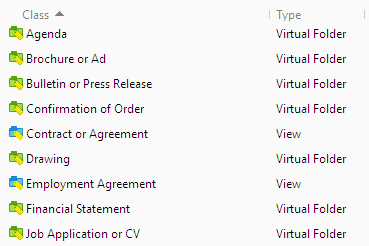Getting Familiar with Views
Views are essentially locations in which the objects are listed based on their metadata. In addition to the M-Files search functions, well-defined views allow you to quickly and easily locate the information you need.
M-Files gathers the contents of a view based on 1) the view filter, which defines the criteria that the object must fulfill to be displayed, and 2) the grouping level settings, which define the categories in which the objects are grouped in the view. As views are based on various metadata-specific criteria, objects can appear in several views at once.
As a very simple example, let's look at the view called Documents by Class. This is a view where the filter simply states that the object type must be Document. As a result, all the documents contained in the vault are listed in this view regardless of their class or any other properties they might have. However, as the name of the view implies, its settings also define a grouping level that categorizes the documents into various virtual folders based on the value of their Class property. This way, we end up with a view like the one shown in the image below.
 A view where documents are categorized by class.
A view where documents are categorized by class.Now, as you can see from the image, views can be further divided in to subviews if need be. Virtual folders can also be converted into views, if you so wish. For more information, see Converting a Virtual Folder into a View.
For instructions on creating a new view and adjusting its settings, see Creating a View.
Now that you have familiarized yourself with views, proceed to Working Offline for a tutorial on how you can use M-Files offline.
